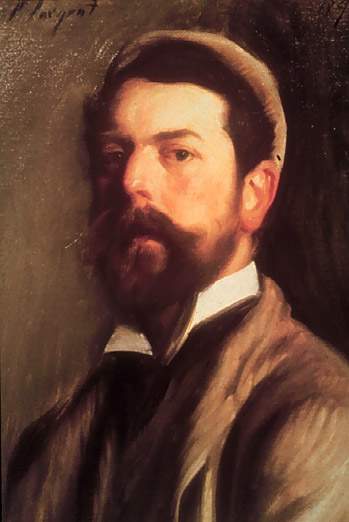
John Singer Sargent
In John Singer Sargent’s biography, he had a unique family background, who supported, and helped nourish his potential for art. Although his parents were American, he himself was born as a European, and traveled abroad to Spain, Holland, and Venice to gain inspiration from works by others. Through time and dedication, he received recognition for his work from England to the United States. What I feel is interesting about his style is that he was influenced by Carolus-Duran to paint immediately rather than make rough sketches first. In the Drawing and Painting classes that I have taken, the teacher has always told us to first do preliminary sketches.

Fumée d’Ambre Gris
The painting, Fumée d’Ambre Gris (The Smoke of Ambergris), drew my attention because it was a cosmopolitan form of description that reached out to the viewer. You have the feeling you are looking at a piece of Moorish architecture because of the pillars, a woman with asiatic and middle-eastern style attire, and most of all, the embroidery and intricacy on the rugs and pottery makes you feel as though you are in a royal setting.
According to Henry James in “Picture and Text,” his paintings such as Young Lady in Black have striking characteristics in which it appears to be simple, yet overflows with perfection. Sargent also had many other diverse influences in his work such as his portrait, Madame X encompassed the style of Edourad Manet and Japanese prints. As James indicates, Sargent takes artistic risk in his paintings because of his curiosity and creativity, which I find brilliant. After analyzing many of his other paintings I also feel that Sergeant puts a lot of effort into his female portraits and paints them with a sense of surreal intensity.

Madame X
I also felt some injustice when his best known piece received criticism because of his indifference to pose, modeling, and spacial treatment. Although Sargent was a nonconformist in the arts during his time period, his lack of symmetrical balancing allows the viewer to take in the work as a whole. Indeed, diverting from what is deemed “normal” and “socially-accepting” during his time period was a gutsy move, and furthermore shows his values and creativity. What was most striking to me was when Sargent changed from being a portraitist and muralist to a watercolorist in his later years. His watercolor paintings seem to be more chiseled in strokes, compared to his crisp oil paintings.

I am also very interested in the point you brought up about Sargent never doing early sketches, and rather just following his instructor. Do you think that this is the premier way of teaching art students? Or can only a great teacher go about this way? Or even maybe it was the natural skill of Sargent that let this method work out?
The Lady in Black is such an interesting painting. I hope you found as much interpretations as I did in such a meaningful work.
I agree with your opinion that “I also felt some injustice when his best known piece received criticism because of his indifference to pose, modeling, and spacial treatment.” I would like to point out that in my brief experience on this Earth, more often than not, people who try to think “outside the box” are met with stark opposition and criticism for the simple fact that people like staying in the realm of what they know and understand well. I think everyone that wants to implement their thoughts on the world, needs to persevere past the initial attack by critics. What do you think about the way people with new ideas are treated?
I agree with you that his Madame X painting shouldn’t have gotten as much harsh criticism as it did. He deviated from the accepted social norms of the time but it was for the sake of art. He was just trying to create something beautiful that was different from the rest.
I agree with Max that your point about Sargent not outlining his paintings beforehand is interesting. I think your previous experience in art probably made that technique stand out to you more so than the rest of us. Would you liken it to improvisation with acting – where film would be working on one part of the painting at a time while theatre is layering the entire canvas at once? Would you say any of these forms of art/acting (improv, film, theatre) require more talent than the others? (Forethought vs spontaneity)
Also, do you think his watercolor work is more socially acceptable and less risky than his portraits? The biography closes with “Sargent engineered his career so astutely that by 1907, when he pledged not to accept any more portrait commissions, he had established a solid reputation as a watercolorist.” Was switching to water color just business sense?
I had the same thought as I was looking at his painting “Madam X.” I believe that this painting was poorly received mainly because of the time period in which it was created. If anytime later it may have been more easily accepted and instead of being known because of how much Madam X was criticized it may of been known for how elaborate and unique the style of painting was. The portrait itself captures the essence and personality of the sitter herself.